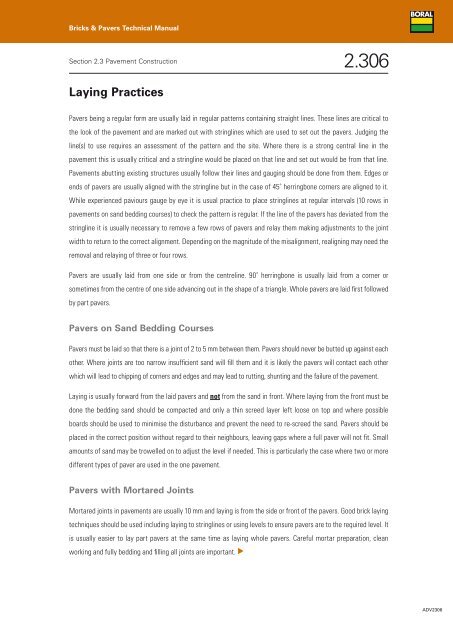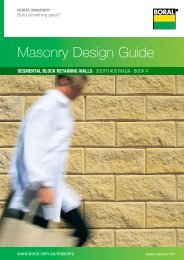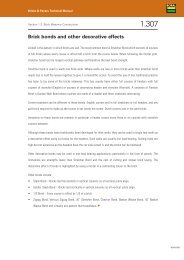Bricks & Pavers Technical Manual - Boral
Bricks & Pavers Technical Manual - Boral
Bricks & Pavers Technical Manual - Boral
Create successful ePaper yourself
Turn your PDF publications into a flip-book with our unique Google optimized e-Paper software.
<strong>Bricks</strong> & <strong>Pavers</strong> <strong>Technical</strong> <strong>Manual</strong><br />
Section 2.3 Pavement Construction<br />
Laying Practices<br />
2.306<br />
<strong>Pavers</strong> being a regular form are usually laid in regular patterns containing straight lines. These lines are critical to<br />
the look of the pavement and are marked out with stringlines which are used to set out the pavers. Judging the<br />
line(s) to use requires an assessment of the pattern and the site. Where there is a strong central line in the<br />
pavement this is usually critical and a stringline would be placed on that line and set out would be from that line.<br />
Pavements abutting existing structures usually follow their lines and gauging should be done from them. Edges or<br />
ends of pavers are usually aligned with the stringline but in the case of 45˚ herringbone corners are aligned to it.<br />
While experienced paviours gauge by eye it is usual practice to place stringlines at regular intervals (10 rows in<br />
pavements on sand bedding courses) to check the pattern is regular. If the line of the pavers has deviated from the<br />
stringline it is usually necessary to remove a few rows of pavers and relay them making adjustments to the joint<br />
width to return to the correct alignment. Depending on the magnitude of the misalignment, realigning may need the<br />
removal and relaying of three or four rows.<br />
<strong>Pavers</strong> are usually laid from one side or from the centreline. 90˚ herringbone is usually laid from a corner or<br />
sometimes from the centre of one side advancing out in the shape of a triangle. Whole pavers are laid first followed<br />
by part pavers.<br />
<strong>Pavers</strong> on Sand Bedding Courses<br />
<strong>Pavers</strong> must be laid so that there is a joint of 2 to 5 mm between them. <strong>Pavers</strong> should never be butted up against each<br />
other. Where joints are too narrow insufficient sand will fill them and it is likely the pavers will contact each other<br />
which will lead to chipping of corners and edges and may lead to rutting, shunting and the failure of the pavement.<br />
Laying is usually forward from the laid pavers and not from the sand in front. Where laying from the front must be<br />
done the bedding sand should be compacted and only a thin screed layer left loose on top and where possible<br />
boards should be used to minimise the disturbance and prevent the need to re-screed the sand. <strong>Pavers</strong> should be<br />
placed in the correct position without regard to their neighbours, leaving gaps where a full paver will not fit. Small<br />
amounts of sand may be trowelled on to adjust the level if needed. This is particularly the case where two or more<br />
different types of paver are used in the one pavement.<br />
<strong>Pavers</strong> with Mortared Joints<br />
Mortared joints in pavements are usually 10 mm and laying is from the side or front of the pavers. Good brick laying<br />
techniques should be used including laying to stringlines or using levels to ensure pavers are to the required level. It<br />
is usually easier to lay part pavers at the same time as laying whole pavers. Careful mortar preparation, clean<br />
working and fully bedding and filling all joints are important. t<br />
ADV2306

















